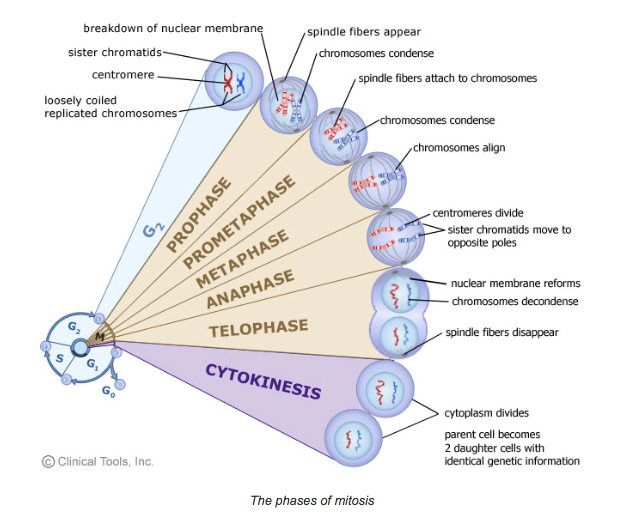Mitosis is a form of cell division that produces two identical copies of the cell and all of its DNA. In order for this to happen, the original cell matter must be copied. Each cell will have every copy of each chromosome from the original cell. This type of cell division is useful for growth, repair and asexual reproduction.
The following stages make up the cell cycle:

G1 phase: All of the cellular matter is duplicated excluding the chromosomes.
S phase: All of the 46 chromosomes (humans) in the cell are duplicated, each chromosome is composed of two sister chromatids.
G2 phase: More metabolic changes occur, cytoplasmic materials and machinery that are needed for mitosis and cytokinesis becomes available and the duplicated chromosomes are checked for error and repaired if needed.
M phase: Division of the nucleus (mitosis) and a cell division (cytokinesis) occurs at the end to make two distinct cells.
M phase is composed of the following stages:
Prophase: During this stage, the nuclear membrane begins to break down and the nucleolus disintegrates. The spindle fibers appear at each end of the cell. The chromosomes condense into structures that are more compact than previously.
Prometaphase: During this stage, the chromosomes condense even further. The chromosomes move to the equatorial plane. The spindle fibers start to bind to the kinetochore, a part of the centromere (holds the sister chromatids together), on each side of the chromosome.
Metaphase: The chromosomes line up along the metaphase plate of the spindle apparatus.
Anaphase: During this stage, the centromeres divide and the sister chromatids are pulled towards opposite poles of the cell. They are pulled by the spindle fibers. When they are separated they are now referred to as daughter chromosomes.
Telophase: This is considered the final stage of mitosis, and works to reform the original contents of the cell before cell division. The nuclear membrane begins to reform around the newly formed daughter chromosomes at each end. The chromosomes begin to uncoil and spindle fibers disappear.
Cytokinesis: This is where the two new cells actually separate. There is a pinching in of the cytoplasm separating the dividing cell into two new identical cells. These cells can then further divide if needed.
Source:
https://www2.le.ac.uk/projects/vgec/highereducation/topics/cellcycle-mitosis-meiosis